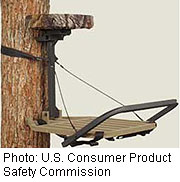
SUNDAY, Feb. 13 (HealthDay News) — Hunters who use tree stands can stay safe if they take proper precautions, say researchers who previously published a study on tree stand safety.
The reminder comes after it was announced that 14 hunters in Alabama fell from tree stands and four died during the recent deer-hunting season. That’s the highest number of deaths from tree stand falls in Alabama in a single year, said the state’s Department of Conservation and Natural Resources.
Across the United States, as many as 30 percent of hunters who use tree stands will have an incident at some point, according to the National Bowhunter Education Foundation’s Project Stand. More than half of those who use tree stands neglect to use a “fall arresting device” and about one-quarter of those who fall from tree stands suffer serious injuries.
“Hunting can be safe — provided hunters have the appropriate training and safety equipment,” Gerald McGwin, an associate director for research at the Center for Injury Science at the University of Alabama at Birmingham, said in a university news release. “Improvements in the safety design and proper use can help to minimize the burden of injury in the hunter population related to tree stands.”
McGwin led a study (published in December 2009 in the Journal of Trauma: Injury, Infection and Critical Care) that identified specific ways to prevent tree stand-related injuries, including education campaigns that recommend the use of safety harnesses and regular maintenance of equipment.
McGwin and colleagues also found that hunters aged 15 to 34 are most likely to suffer serious injuries in tree stand-related accidents. This may be because hunters in this age group take more risks, have less exposure to safety information, and spend more time hunting than older hunters.
“The vulnerable, young hunter population should be specifically targeted to decrease the number of preventable injuries,” McGwin said.
Common injuries that occur among those who fall from tree stands include: fractures (often in the hip or lower extremities); and torso, shoulder and upper extremity injuries. While less common, head and spinal cord injuries do occur and can be significant.
More information
The Maryland Department of Natural Resources offers tree stand safety tips.

